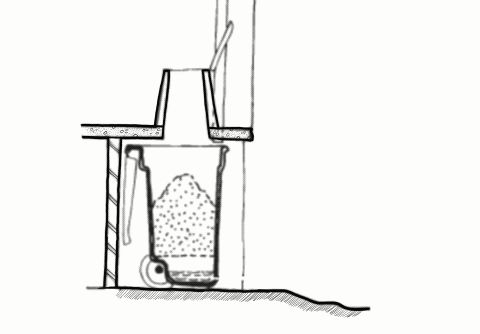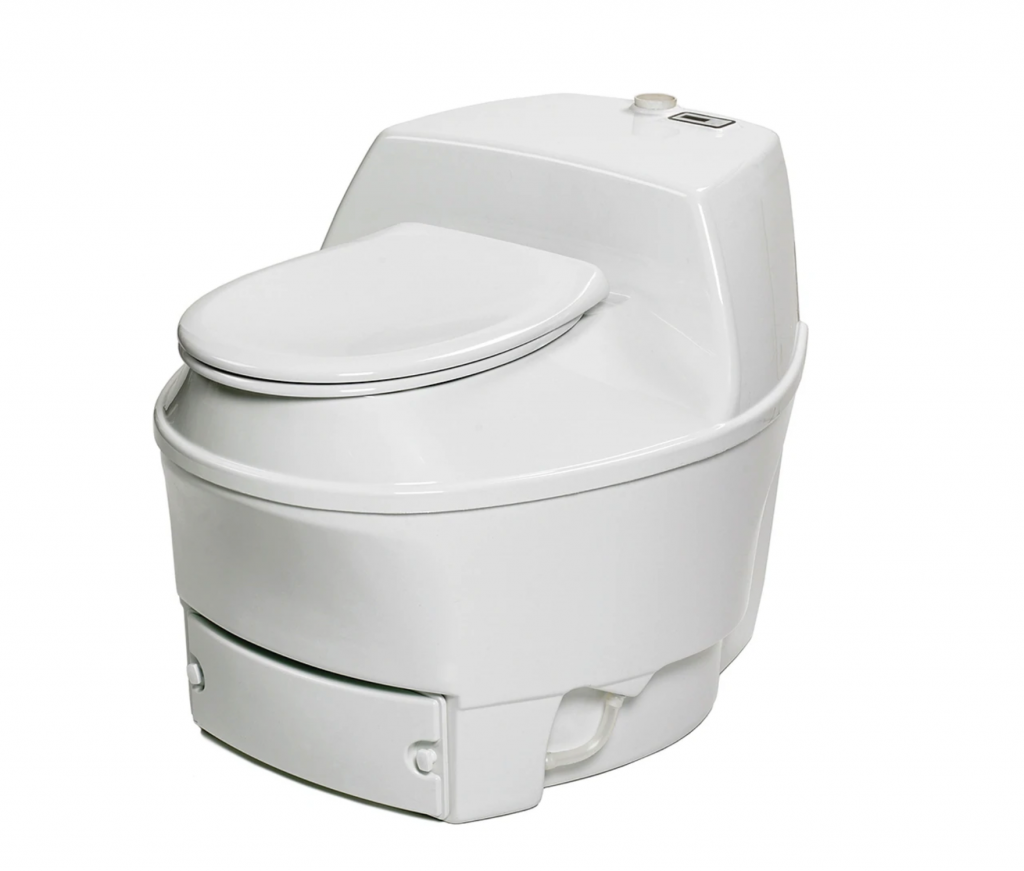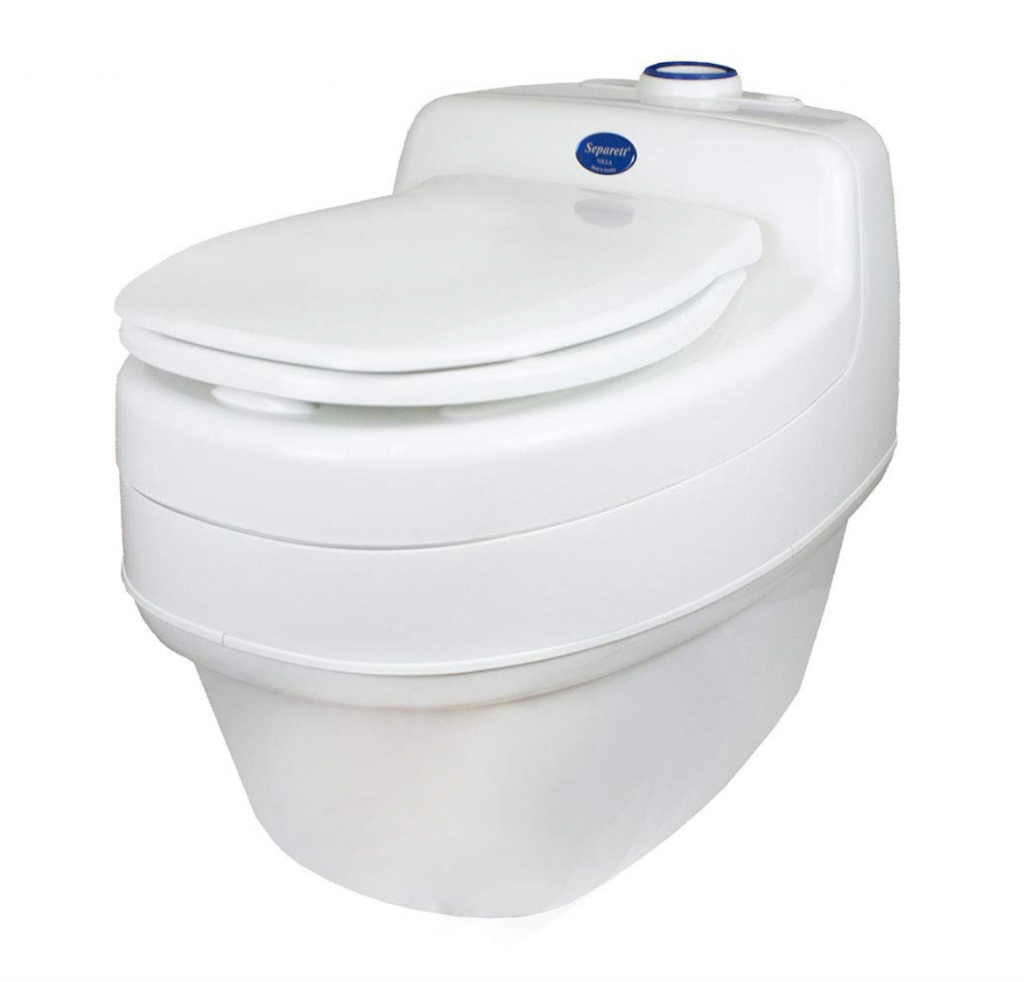Many of you out there may be unfamiliar with composting toilets – these ingenious systems have been tried and tested throughout numerous rural communities for many years.
They are a type of dry toilet, meaning they don’t need water to work. In communities where water is scarce, this type of toilet has helped keep many areas sanitary.
In fact, using a composting toilet can save 6600 gallons of water a year!
Even in our more urban areas where proper sewage and sanitary infrastructure is available – should we really be soiling clean water? Water that we could use for drinking or cooking?
If we’ve piqued your interest, keep reading! We explore everything you need to know about composting toilets!
Table of Contents
What Is A Composting Toilet?
A composting toilet is a waterless toilet that allows you to turn feces into nutrient-rich “compost” which you can then use for your garden.
Water pollution from sewage is a larger issue than you might think.
According to the United States Environmental Protection Agency (EPA), around 772 cities in the U.S. have joint sewer systems. This means that wastewater and rainwater runoff into the same system.
When these systems flood due to heavy rain, the polluted water contaminates and harms the surrounding environment.
Not to mention that 2.3 billion people around the world don’t have access to basic sanitation facilities.
A Major Bonus
You can install a composting toilet almost anywhere as they do not depend on existing sewage lines or facilities.
What’s more, they don’t require water to work and you implement them on both public and private scales.
While may shrug this topic off and see it as gross or unhygienic, modern ingenuity has made it safe and sanitary
While you may see this system as gross or unhygienic, modern inventions have made it safe and sanitary -now they don’t even smell!
The Golden Rules
However, there are 3 golden rules to follow when using composting toilets:
- Make sure that there are no codes or regulations in your area that prohibit composting toilets. Some states or local governances prohibit the disposal of dry-toilet waste.
- Always mix the compost in with the existing soil. We advise that you cover the compost with at least 3 inches of soil.
- Above all – Do not use the compost for fruit/vegetable gardens. The pathogens and other bacteria can infect your plants, causing illness like salmonella.
How Does A Composting Toilet Work?
Composting toilets take advantage of aerobic bacteria that break down organic matter. These bacteria break down the human waste, turning it into a compost-like substance.
That’s right, composting toilets don’t make actual compost. However, the end result is still nutrient-rich.
There are three types of composting toilets, each working a little differently:
- Continuous compost toilets
- Batch compost toilets
- Self-contained compost toilets
Continuous Compost Toilets
A continuous compost toilet only has one chamber in which human waste moves through gradually. As it moves through the chamber, it slowly decomposes. Finally, when it reaches the external hatch, it’s ready to be dug out and disposed of.

Source: Climatebiz
Batch Compost Toilets
In this compost toilet system, you deal with the waste in batches. The system requires that you use 2 or more containers, alternating them when necessary.
Once you fill one container, you remove it and replace it with an empty one. Then you leave the full container for up to six months whilst the waste decomposes.

Source: Climatebiz
Self-contained Compost Toilets
Self-contained compost toilets are the most common type of composting toilets on the market.
These are similar to toilets in RVs – the human waste falls from the toilet bowl and into a container that you attach to the toilet. You can then detach the container from the toilet seat and empty it.

Source: Istock
How Much Does A Composting Toilet Cost?
Composting toilets are constantly evolving and there are a ton of different types on the market. The cost will vary depending on the type of toilet.
For example, an extremely simple self-contained composting toilet can start at around $600.
However, more complex toilets (which work much better than the above-mentioned option) go for around $1,500/$3,000.
If these prices send chills down your spine and make your wallet ache, you should put them into context.
Septic tanks (another off-grid option) can cost 30% more than composting toilets. Not to mention the time and construction needed to install the tank.
Can You DIY A Composting Toilet?
Yes, you can!
Building a DIY composting toilet can save you a lot of money but there are some downsides.
When building your own composting toilet, it can be tricky to keep everything to regulation. You’d need to get a professional to approve of the design before building.
In addition, if you don’t build your toilet properly you can be left with a composting toilet that smells or clogs up.
We recommend using a batch composting toilet if you’re going to build one yourself. They’re easier to build and simple to maintain.
Do Composting Toilets Work?
Composting toilets are an effective way to break down feces into a soil-like fertilizer. You can then use this “compost” which is high in nutrients for your ornamental gardens.
Grab your lab coat because we’re about to explore the science of composting toilets.
A Little Bit Of Science
Aerobic bacteria break down the human waste, leaving nutrient-rich compost as an end-product. However, these bacteria need just the right conditions to work effectively.
A temperature between 60 – 100 degrees Fahrenheit is required in order for the bacteria to thrive. That, along with the right amount of moisture and carbon-nitrogen material.
Carbon-nitrogen material refers to organic material like mulch or wood chips. Just like in a normal compost heap, these organic materials make the compost packed with nutrients.
That leaves the issue of moisture.
Solids Vs. Liquids
Unless it’s a urinal, toilets deal with both solids and liquids.
We’ve looked at how composting toilets deal with solid waste, but what about urine?
When you leave urine to decompose, the urea present turns into ammonia. This kills the bacteria that break down the waste, stopping the process and causing an odor.
Therefore, a mix of urine and feces just doesn’t work. Separating the liquids from the solids becomes a vital part of the decomposition process.
You can achieve this by allowing the liquids to filter through and drain into a separate pan. There, you can safely dispose of it or allow it to evaporate.

Source: toilettech
How Do You Empty A Composting Toilet?
Emptying your composting toilet will depend on your type and model of toilet. Self-containing toilets empty differently from continuous composting toilets.

Emptying your compost toilet would be like shoveling topsoil in your garden. There’s no smell or any resemblance to human waste at all.
The best thing to do before emptying your compost toilet is to contact the supplier and ask them for some guidelines.
Some self-contained composting toilets have a tray that you simply remove, empty, and put back. Batch composting toilets are simple as you just remove the container and insert an empty one.
However, there are some general guidelines that you can apply to all types:
- Always use protective gloves when dealing with the compost.
- Ensure that you wash your hands thoroughly after spreading with the compost.
- Make sure that you mix the compost in with existing top soil. The compost should be covered with 3 inches of topsoil.
How Frequently Should You Empty A Composting Toilet?
How frequently you empty your composting toilet depends on the size of your system and how large your household is. However, the general rule of thumb is that you should only use the compost after 6 months.
The size of your system will determine your storage capacity. How often you use the system will determine how fast you’ll need to empty it.
Your immediate climate also plays a role here. As previously mentioned, aerobic bacteria are most efficient in 60 – 100 degrees Fahrenheit conditions. Those in colder climates will need to keep their systems warmer to stay in this temperature sweet spot.
But Why Wait 6 Months?
Many pathogens and harmful microbes have evolved to survive outside of your body for extended periods of time.
For example, it takes microbes that cause gastroenteritis 2 months to become noninfectious. Certain parasites lay eggs that can survive for 6 months before hatching.
Therefore, waiting 6 months before using the compost is for your own safety. It takes 6 months for the bacteria to decompose the solids and for harmful microbes to die.
Can You Use A Composting Toilet In Your Home?

Source: BioLet
Most composting toilets are designed and built to fit right into your home. Some look a little clunky, others need more space. But certain composting toilets look like they fit right in!
There are a few things to keep in mind when installing a composting toilet in your home.
First, the type of toilet you use depends on how much space you have in, and under your bathroom.
Small self-contained composting toilets can fit in any bathroom, but batch and continuous toilets need more space. Batch and continuous composting toilets need space for their systems and containers.
If you have a home that has a basement or a crawlspace, it’s possible to install all types of composting toilets. However, if your home is built straight onto a foundation, your choice will be limited.
Whatever you chose, installing a composting toilet in your home is a great way to save water and become more eco-friendly.
What Are The 3 Best Composting Toilets?
If you’ve made it this far, well done! Now it’s time to have a look at the products out there.
We’ve rounded up a list of composting toilets you can buy, just in case we’ve convinced you to install one.
#1 – Nature’s Head Self Contained Composting Toilet

Main Features
This self-contained composting toilet is a good starter option for those of you with limited space.
Some highlights for you – it separates liquids and solids, it’s easy to install and it has a decent tank size. You can also use it 80 times before the tank needs to be emptied.
However, we’ve scoured the reviews and it’s not for the faint-hearted. Due to the fact that you need to empty the tanks so often, the waste hasn’t decomposed properly.
It’s also important to note that carbon material like wood chips or mulch will be needed to help soak up any excessive moisture.
#2 – BioLet Composting Toilet 65a

Main Features
The BioLet composting toilet is completely automatic. From separating solids and liquids to rotating the solids chamber for equal distribution.
It also regulates its own heat extremely well, speeding up the decomposition process.
The compost collects in a bottom tray that can easily be removed, cleaned, and put back. An LED light lets you know when the tray is full.
This composting toilet is perfect for those of you who are squeamish but still want to give composting toilets a try.
#3 – Separett Villa 9215

Main Features
The Separett Villa 9215 has a 4.5-star rating on Amazon with great reviews!
If you’re looking for a composting toilet that looks and feels just like a conventional one, this product is for you!
The toilet has a compostable bin liner that catches the solids. Simply remove the liner and throw it into a separate container for composting.
The toilet is wall-mounted and also allows you to connect its liquid collector to your greywater system.
Final Thoughts
Composting toilets are toilets that don’t need water or a sewer system to work. This provides many rural areas with basic sanitation that they otherwise wouldn’t have
These toilets can save up to 6,600 gallons of water a year per person! This makes them both an off-grid and water-wise solution.
By installing one in your home, you can turn human waste into nutrient-rich “compost” for your gardens.
The only downside to composting toilets is that they can be a lot of maintenance and aren’t for the faint-hearted.
But if you can get over the initial thought of it, composting toilets are a great option. They save water and curb environmental pollution.

